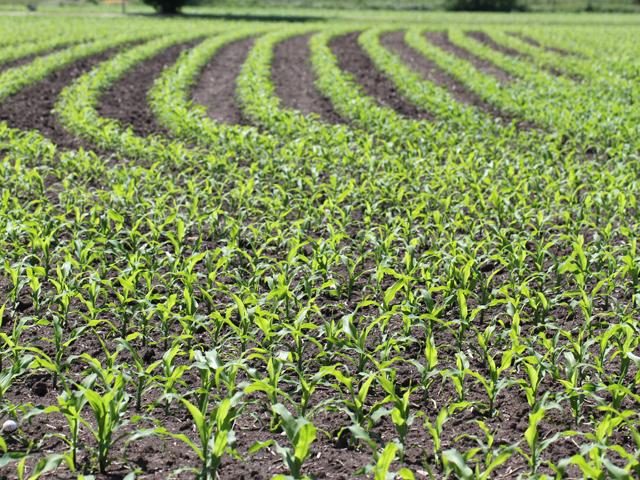Large Crops Equal Large Price Declines
Corn Futures Dip Below $5 and Soybeans Below $12 in Market Moves
OMAHA (DTN) -- Corn and soybean futures prices are falling to two-year lows, reflecting the forecasts for large crops in both the U.S. and Brazil, as the December corn contract settled below $5 a bushel on Wednesday and the November soybeans contract dropped below $12.
The December corn futures contract fell to $4.94 a bushel before rallying to $4.99, marking the first time the December contract has dipped below the $5 mark since the contract briefly fell below $5 in 2021. Overall, though, prices for the December 2023 contract risk falling to levels not seen since April 2021.
The November soybean contract fell from $12.07 a bushel down to $11.87 1/2 a bushel. Like corn, soybean prices dipped briefly below the $12 mark at harvest 2021, but overall, prices for the November contract are approaching their lowest levels since February 2021.
FARMER: DON'T BE ALARMIST
Lance Lillibridge, chairman of the Iowa Corn Growers Association, cautioned against becoming too alarmist about a price decline in the futures market. Lillibridge also noted farmers are coming off of two good years despite higher input prices over that stretch. "The American farmer right now is sitting pretty good as far as cash goes. We're long cash, right?"
There are a lot of daily headlines driving futures such as China canceling more corn contracts, as well as conversations about the debt ceiling and risks of a government default, Lillibridge noted. Still, the weather is good, and crops are being quickly planted, he added, stressing there is a lot that could happen between now and harvest.
"From this point on, even if we get a crop in, it could dry up, or we could get flooded. We could have a derecho," he said, adding that the war in Ukraine could intensify or shutdown the Black Sea grain deal. "There are just so many things that can happen and change the marketplace."
In the meantime, the ethanol market was protected with another decision to allow year-round E15, and companies are moving ahead with plans to expand domestic soybean crush as well, Lillibridge noted.
P[L1] D[0x0] M[300x250] OOP[F] ADUNIT[] T[]
"There are still a lot of positive things that are happening in the agriculture industry," he said. "Sometimes we just kind of have to look the other way for a few minutes."
While prices on those futures contracts are falling, Lillibridge said farmers have built a lot of storage over the past decade, and a lot of them will likely hold on to that corn crop in the fall and watch their basis. In his own operation, Lillibridge said he has enough storage to put away every bushel if necessary.
"If processors want to pull that corn into the supply chain, it's going to come from basis," he said. "So, if we're looking at the futures market, saying, 'Well, gosh, it's below five bucks, the sky is falling,' depending on where you're at, the basis is still pretty good, and that could be our saving grace."
CORN
It's mid-May and a lot of the U.S. corn crop isn't even planted yet, but markets are reacting to last week's forecast by USDA of a record 15.26-billion-bushel corn crop for 2023-24 along with ending stocks expected at 2.2 billion bushels.
"It's a combination of expecting a second year of record production in Brazil followed by an expected record cop in the U.S.," said DTN Lead Analyst Todd Hultman. "Between these two things, that's a lot of supply."
China also is anticipating a large safrinha corn crop out of Brazil, which already has a $4.68-a-bushel price on its July contract. "They (Chinese buyers) already have their eye on cheaper corn," Hultman said.
Coming out of back-to-back years with the average farm price above $6 a bushel, USDA's forecast in the May World Agricultural Supply and Demand Estimates (WASDE) Report was $4.80 a bushel.
The crop insurance guarantee, at an 80% protection level, was set back in February at $4.73 a bushel.
SOYBEANS
November soybeans fell 19.5 cents on Wednesday to $11.87 1/2, as Brazil is delivering on a 5.7-billion-bushel crop, and USDA has forecast a record 4.5-billion-bushel crop from U.S. farmers as well.
USDA anticipates the average farm price at $12.10 a bushel for the 2023-24 marketing year, a $2.20 decline from the old crop.
Looking at crop insurance, the 80% protection level for soybean policies came in at $11 a bushel.
Also see "Fertilizer Prices Moving in Two Directions" here:
Chris Clayton can be reached at Chris.Clayton@dtn.com
Follow him on Twitter @ChrisClaytonDTN
(c) Copyright 2023 DTN, LLC. All rights reserved.





